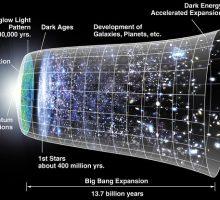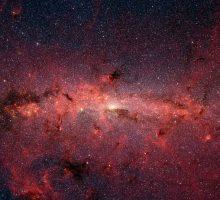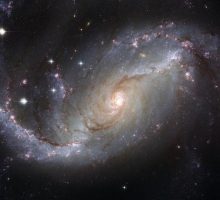- The History and Evolution of the Big Bang Theory
- What Caused the Big Bang? Exploring Theories and Hypotheses
- The Timeline of the Big Bang: From Singularity to the Formation of the Universe
- The Cosmic Microwave Background Radiation: Evidence for the Big Bang Theory
- Dark Matter and Dark Energy: Key Players in the Big Bang Theory
- The Inflationary Universe Theory: How It Shapes Our Understanding of the Big Bang
- The Origin of the Elements: How They Were Formed During the Big Bang
- The Multiverse Theory: Implications for Our Understanding of the Big Bang
- Big Bang Cosmology and the Search for Extraterrestrial Life
- Debates and Controversies in Big Bang Cosmology: A Critical Analysis.
The History and Evolution of the Big Bang Theory
The Big Bang Theory is the most widely accepted scientific theory for the origins of the universe. It states that the universe began as a singularity – a point of infinite density and temperature – and has been expanding ever since. In this blog, we will explore the history and evolution of the Big Bang Theory and how it has changed over time.
The idea of an expanding universe was first proposed by Belgian astronomer Georges Lemaitre in 1927. He suggested that the universe began as a single point and has been expanding ever since, a concept that was initially met with skepticism by many scientists. However, in 1929, American astronomer Edwin Hubble confirmed Lemaitre’s theory through his observations of distant galaxies.
In the 1940s, physicist George Gamow and his colleagues proposed that the early universe was extremely hot and dense, and that it had expanded and cooled over time. This idea, known as the Hot Big Bang Theory, gained traction in the scientific community.
In the 1960s, the discovery of cosmic microwave background radiation provided strong evidence for the Big Bang Theory. This radiation is thought to be the remnants of the early universe, and its discovery helped to solidify the idea that the universe began as a singularity and has been expanding ever since.
Since then, the Big Bang Theory has continued to evolve. In the 1980s, physicist Alan Guth proposed the concept of cosmic inflation, which suggests that the universe expanded rapidly in the moments after the Big Bang. This theory helps to explain why the universe appears to be so uniform in temperature and density.
Today, the Big Bang Theory is widely accepted as the most accurate explanation for the origins of the universe. It has been supported by a range of scientific evidence, including observations of the cosmic microwave background radiation and the abundance of light elements in the universe.
However, there are still some questions that remain unanswered. For example, scientists are still trying to understand the nature of dark matter and dark energy, which are thought to make up a significant portion of the universe. Additionally, some scientists have proposed alternative theories to the Big Bang, such as the Steady State Theory and the Cyclic Model.
What Caused the Big Bang? Exploring Theories and Hypotheses
The Big Bang Theory is the most widely accepted scientific explanation for the origins of the universe. It states that the universe began as a singularity – a point of infinite density and temperature – and has been expanding ever since. But what caused the Big Bang? In this blog, we will explore the different theories and hypotheses that attempt to answer this question.
One popular hypothesis is that the universe was created by a cosmic explosion. This idea suggests that the universe began as a single point of infinite density and temperature, and that this point exploded, leading to the expansion of the universe. However, this idea is controversial and lacks a clear explanation of what caused the explosion.
Another theory is that the universe was created by a quantum fluctuation. This idea suggests that the universe was created when a quantum fluctuation caused a region of space to undergo rapid expansion, resulting in the formation of the universe. While this theory is supported by some scientists, it is still speculative and lacks conclusive evidence.
One of the most promising theories is that the universe was created by a cosmic inflationary event. This idea suggests that the universe underwent a period of rapid expansion in the moments after the Big Bang, which was caused by a process known as inflation. This theory helps to explain why the universe appears to be so uniform in temperature and density, but it still requires further evidence to be confirmed.
Other theories include the idea that the universe is part of a larger multiverse, and that our universe was created through a natural process within this larger system. Some scientists have also proposed the idea that the universe is cyclical, and that it goes through a series of expansions and contractions over time.
Ultimately, the question of what caused the Big Bang remains unanswered. While scientists have proposed a range of theories and hypotheses, none of them have been confirmed through direct observation or conclusive evidence. Nevertheless, the search for an answer continues, as scientists work to unlock the mysteries of the universe and understand the origins of our existence.
The Timeline of the Big Bang: From Singularity to the Formation of the Universe
The Big Bang Theory is the most widely accepted scientific explanation for the origins of the universe. It states that the universe began as a singularity – a point of infinite density and temperature – and has been expanding ever since. In this blog, we will explore the timeline of the Big Bang, from the singularity to the formation of the universe as we know it.
The universe is thought to have begun approximately 13.8 billion years ago. At that time, the entire universe was contained within a single point of infinite density and temperature, known as the singularity. This singularity was so hot and dense that the laws of physics as we know them did not yet exist.
In the first fraction of a second after the Big Bang, the universe underwent a period of rapid expansion known as inflation. This inflationary period lasted for only a fraction of a second, but it set the stage for the formation of the universe as we know it today.
As the universe continued to expand and cool, particles began to form. In the first few minutes after the Big Bang, protons and neutrons began to combine to form the nuclei of atoms, such as hydrogen and helium. This period is known as nucleosynthesis, and it was a critical step in the formation of the universe.
Over the next few hundred million years, the universe continued to expand and cool. As it did so, the first galaxies and stars began to form. These early galaxies were much smaller and less complex than the ones we see today, but they played a critical role in the formation of the universe.
Over time, these early galaxies merged and grew, forming the large galaxies we see today. Stars continued to form and die, enriching the universe with heavier elements such as carbon, oxygen, and iron.
Today, the universe is still expanding, and we continue to learn more about its origins and evolution. Scientists use a range of tools and techniques to study the universe, including telescopes, satellites, and computer simulations.
The Cosmic Microwave Background Radiation: Evidence for the Big Bang Theory
One of the most compelling pieces of evidence for the Big Bang Theory is the Cosmic Microwave Background Radiation (CMBR). In this blog, we will explore what the CMBR is, how it was discovered, and what it tells us about the origins of the universe.
The CMBR is a form of electromagnetic radiation that permeates the universe. It was first predicted by the Big Bang Theory, which suggested that the universe should have been filled with a glowing, hot plasma in its early stages. As the universe expanded and cooled, this plasma should have cooled as well, eventually forming a background of microwave radiation.
In the 1960s, two scientists named Arno Penzias and Robert Wilson discovered the CMBR while studying radio waves in the sky. They found a faint, uniform signal that was present no matter where they pointed their antenna, and they could not explain it. It wasn’t until they learned about the Big Bang Theory that they realized they had discovered the CMBR.
Since its discovery, the CMBR has been extensively studied by scientists around the world. One of the key findings from this research is that the CMBR is remarkably uniform, with the same temperature and intensity in all directions. This uniformity is one of the key pieces of evidence supporting the Big Bang Theory, which predicts that the universe should have been very uniform in its early stages.
Another important discovery related to the CMBR is the small variations in temperature and intensity that are present in the radiation. These variations are thought to be the result of small differences in density in the early universe, which eventually led to the formation of galaxies and other structures we see today.
Overall, the CMBR is one of the most important pieces of evidence supporting the Big Bang Theory. Its discovery and study have helped to confirm many of the predictions made by the theory, and it continues to be an area of active research for scientists around the world.
Dark Matter and Dark Energy: Key Players in the Big Bang Theory
Dark matter and dark energy are two of the most mysterious and fascinating components of the universe. They play a key role in the Big Bang Theory, helping to explain the structure and behavior of the universe on a large scale. In this blog, we will explore what dark matter and dark energy are, how they were discovered, and their significance in the Big Bang Theory.
Dark matter is a form of matter that does not interact with light or other forms of electromagnetic radiation. It is invisible and cannot be detected directly, but its presence can be inferred from its gravitational effects on visible matter, such as stars and galaxies. Scientists estimate that dark matter makes up around 85% of the total matter in the universe.
The existence of dark matter was first proposed in the 1930s by Swiss astronomer Fritz Zwicky, who observed the behavior of galaxies in the Coma Cluster. He noticed that the visible matter in the cluster was not sufficient to account for the observed gravitational effects, leading him to propose the existence of an invisible, non-interacting form of matter.
Since then, numerous experiments and observations have provided further evidence for the existence of dark matter. Its presence is essential to explaining the formation and structure of galaxies, as well as the observed patterns of cosmic microwave background radiation.
Dark energy, on the other hand, is a form of energy that is thought to permeate the entire universe, causing it to expand at an accelerating rate. Unlike dark matter, dark energy does not interact with matter or radiation in any way, making it even more mysterious and difficult to study.
The existence of dark energy was first inferred in the late 1990s by two independent teams of astronomers who were studying the distant light from supernovae. They found that the expansion of the universe was accelerating, rather than slowing down as expected. This observation led to the proposal of dark energy as a possible explanation.
Since then, numerous experiments and observations have provided further evidence for the existence of dark energy. Its presence is essential to explaining the accelerating expansion of the universe and the large-scale structure of the cosmos.
The Inflationary Universe Theory: How It Shapes Our Understanding of the Big Bang
The Inflationary Universe Theory is a fascinating and widely accepted extension of the Big Bang Theory that helps to explain many of the mysteries of the universe. In this blog, we will explore what the Inflationary Universe Theory is, how it was discovered, and its significance in shaping our understanding of the Big Bang.
The Inflationary Universe Theory proposes that the universe underwent an incredibly rapid expansion, known as inflation, in the first few moments after the Big Bang. This expansion was so rapid that it caused the universe to grow from a subatomic size to a size much larger than the observable universe in less than a second.
The theory was first proposed in the 1980s by cosmologist Alan Guth, who was trying to solve the problem of the horizon and flatness of the universe. The horizon problem arises from the fact that the observable universe is remarkably uniform, with the same temperature and structure in all directions. However, this uniformity would require information to have traveled faster than the speed of light, which is impossible according to the laws of physics. The flatness problem arises from the fact that the universe is observed to be very close to flat, which is unexpected given the curvature of spacetime predicted by the Big Bang Theory.
Guth proposed that inflation could solve both of these problems. By causing the universe to expand rapidly in the early stages, inflation would have stretched out any non-uniformities to the point where they were no longer observable. This would have also caused the universe to be very close to flat, as any curvature would have been smoothed out during inflation.
Since then, numerous experiments and observations have provided evidence supporting the Inflationary Universe Theory. For example, observations of the cosmic microwave background radiation have shown that the universe is remarkably uniform, with only very small variations in temperature and intensity. These variations are thought to be the result of quantum fluctuations that were amplified during inflation.
Overall, the Inflationary Universe Theory is a key extension of the Big Bang Theory, helping to explain many of the mysteries of the universe. Its discovery and study have provided valuable insights into the origins and evolution of the cosmos, and it continues to be an area of active research for scientists around the world.
The Origin of the Elements: How They Were Formed During the Big Bang
The origin of the elements is a fascinating and important aspect of the Big Bang Theory. It explains how the elements that make up our world were formed in the early universe. In this blog, we will explore how the elements were formed during the Big Bang, and the significance of this process in understanding the evolution of the universe.
The Big Bang Theory proposes that the universe began as a hot, dense, and rapidly expanding state, known as a singularity. In this state, the only elements that existed were hydrogen, helium, and trace amounts of lithium. Over time, these elements combined to form stars and galaxies, eventually leading to the formation of the elements that make up our world today.
The process by which the elements were formed is known as nucleosynthesis. During the first few minutes of the Big Bang, the high temperatures and densities allowed protons and neutrons to combine to form the nuclei of helium, lithium, and other light elements. This process is known as primordial nucleosynthesis, and it is responsible for the creation of about 25% helium and trace amounts of lithium.
The rest of the elements were formed in the cores of stars through a process known as stellar nucleosynthesis. Stars fuse lighter elements together to form heavier elements, eventually leading to the formation of elements such as carbon, nitrogen, and oxygen. When a star dies, it releases these elements back into the universe, allowing them to be recycled into new stars and planets.
The study of the origin of the elements has important implications for our understanding of the universe. It helps us understand how the elements that make up our world were formed and how they are distributed throughout the universe. It also provides insights into the early stages of the universe and the conditions that existed in the first few minutes after the Big Bang.
The Multiverse Theory: Implications for Our Understanding of the Big Bang
The Multiverse Theory is a fascinating and controversial extension of the Big Bang Theory that proposes the existence of multiple universes, each with its own unique set of physical laws and properties. In this blog, we will explore what the Multiverse Theory is, how it relates to the Big Bang Theory, and its implications for our understanding of the universe.
The Multiverse Theory proposes that our universe is just one of many universes that exist in a larger multiverse. Each universe in the multiverse is thought to have its own set of physical laws and properties, which could be different from those in our own universe. This means that there could be universes with different constants of nature, different numbers of dimensions, or even different types of matter and energy.
The idea of a multiverse has important implications for our understanding of the Big Bang Theory. One of the key problems with the Big Bang Theory is that it cannot explain why the physical constants of our universe are fine-tuned to allow for the existence of life. The Multiverse Theory proposes that this fine-tuning is not a coincidence, but rather the result of a selection effect – we only observe a universe with physical laws that allow for our existence because we could not exist in a universe with different physical laws.
Another implication of the Multiverse Theory is that it could help to explain some of the mysteries of the universe, such as dark matter and dark energy. In some versions of the Multiverse Theory, dark matter and dark energy could be the result of interactions between our universe and other universes in the multiverse.
Despite its potential implications, the Multiverse Theory is still a highly controversial and speculative idea. It is difficult to test or prove the existence of other universes, and some scientists have criticized the theory as unscientific or unfalsifiable.
Big Bang Cosmology and the Search for Extraterrestrial Life
The Big Bang Cosmology is the prevailing scientific theory that explains the origins of the universe, but it has also sparked interest in the search for extraterrestrial life. In this blog, we will explore the connection between Big Bang Cosmology and the search for extraterrestrial life, and how scientists are using this theory to discover if life exists beyond Earth.
The Big Bang Cosmology explains the origin and evolution of the universe as we know it. It proposes that the universe began as a hot, dense, and rapidly expanding state, and has been expanding and cooling ever since. This theory has allowed scientists to understand the properties of the universe, from the formation of galaxies and stars to the composition of matter.
One of the most interesting implications of the Big Bang Cosmology is the idea that the universe is vast and teeming with possibilities for life. The universe is estimated to contain billions of galaxies, each containing billions of stars, many of which may have planets that could support life. This has led scientists to ask the question: are we alone in the universe?
The search for extraterrestrial life is an active field of research, and scientists are using the principles of Big Bang Cosmology to guide their investigations. One approach is to search for planets that are similar to Earth in terms of their distance from their star, their size, and their composition. These planets are thought to have a higher likelihood of hosting life as we know it.
Another approach is to search for signs of life beyond Earth, such as radio signals or other evidence of advanced technology. The search for extraterrestrial intelligence (SETI) is an example of this approach, and it has been ongoing for decades. While no definitive evidence of extraterrestrial life has been found, the search continues to be a topic of interest and fascination for scientists and the public alike.
The connection between Big Bang Cosmology and the search for extraterrestrial life is a reminder of the vastness and complexity of the universe. While the search for life beyond Earth remains a challenge, the principles of Big Bang Cosmology provide a foundation for understanding the universe and the possibilities it holds.
Debates and Controversies in Big Bang Cosmology: A Critical Analysis.
The Big Bang Cosmology has been the subject of many debates and controversies among scientists and the general public alike. While the theory has been widely accepted as the best explanation for the origins of the universe, there are still those who challenge and criticize its assumptions and conclusions. In this blog, we will critically analyze some of the debates and controversies surrounding Big Bang Cosmology.
One of the main criticisms of the Big Bang Cosmology is the concept of the singularity, which is the point of infinite density and temperature from which the universe is said to have originated. Some scientists argue that the concept of a singularity is a mathematical artifact and that it does not reflect the true nature of the universe at the moment of its birth. Others argue that the singularity is a genuine physical phenomenon and that it requires further study and understanding.
Another controversy surrounding the Big Bang Cosmology is the so-called “horizon problem.” This problem arises from the fact that the universe appears to be uniform and isotropic on a large scale, even though different regions of the universe were not in causal contact with each other at the moment of the Big Bang. Some scientists have proposed alternative theories, such as the “inflationary universe” hypothesis, to explain this apparent contradiction.
Another area of debate in Big Bang Cosmology is the concept of dark matter and dark energy, which are believed to make up most of the mass and energy in the universe, respectively. While their existence has been inferred from observations of the behavior of galaxies and the cosmic microwave background radiation, their nature and properties remain largely unknown. Some scientists have proposed alternative explanations, such as modifications to the laws of gravity, to account for the observed phenomena without the need for dark matter or dark energy.
Finally, the anthropic principle, which states that the observed properties of the universe must be compatible with the existence of intelligent life, has also been the subject of debate and controversy. Some scientists argue that the anthropic principle is a useful tool for making predictions and understanding the nature of the universe, while others criticize it as unscientific and unfalsifiable.













